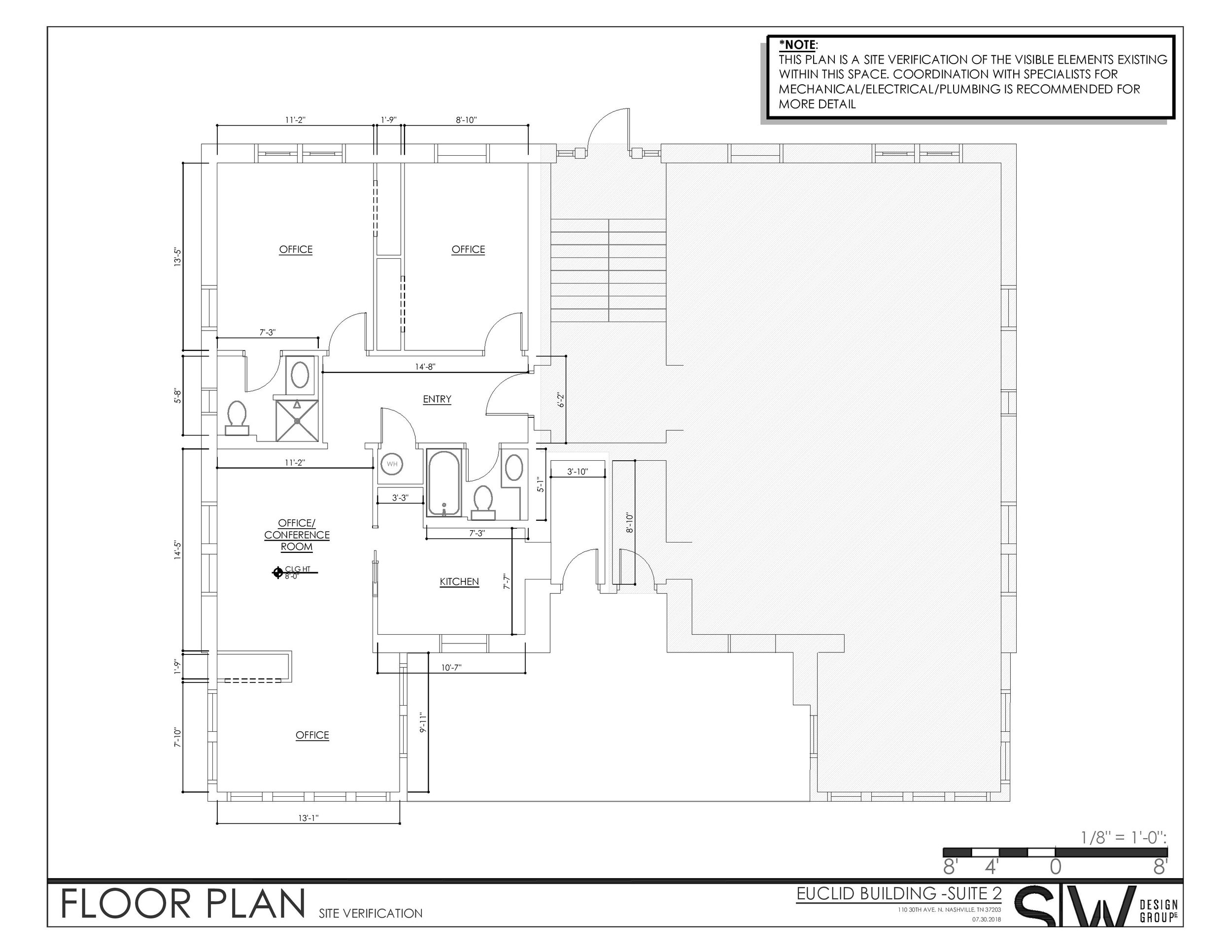
Live-Work Space
Live-work space is any type of real estate that is zoned for both residential and commercial uses.
Most zoning codes (and therefore, most projects) are either one or the other - restricting your ability for both.
The convenience to live and work in the same space is a rarity in Nashville these days.
It's not very often that you'll come across a project suitable for this use, but new construction is picking up.
With traffic on the rise and the freedom to work from anywhere, many entrepreneurs are looking to an "all in one" solution with live-work space.
110 30th Avenue North
110 30th Avenue North, also know as Euclid Court, is zoned Office/Residential Intensive - allowing for both residential and commercial occupants.
Located one block off West End, Euclid Court is walking distance to Duet Boutique, Bricktop's, and Centennial Park.
Midtown is a shopping and business hub, thanks to Vanderbilt University and ease of access to I-440 / I-65.
You're also only 10 minutes from downtown - not to mention 21st Ave and Hillsboro Village.

What's Available at Euclid Court
The owners prefer to lease 110 30th Ave North but will also consider a sale.
The condo is 1,196 square feet and features two bedrooms (or offices), two full baths, a living room, a study, and a full kitchen with storage.
The suite is well-balanced between an open and private floor plan and has abundant light since it's a corner unit.
One assigned parking spot comes with the unit and there is open street parking on all sides of the building.
Looking for a location convenient to the amenities of midtown where you can live and work?
You've found it here.
“Most people think about their first deal. Few think about their last.”
That quote stuck with me the first time I heard it. It’s a reminder that in commercial real estate, the endgame matters just as much as your entry point. Too many investors pour all their energy into getting that first property across the finish line only to realize they never thought about where it was actually taking them.
Commercial real estate isn’t just about buying buildings. It’s about building something bigger than yourself: a business, a portfolio, a legacy. Without a clear vision, your investing journey can start to feel like spinning plates, one more deal, one more tenant, one more issue to solve. But with the right long-term strategy, every property becomes a stepping stone toward financial freedom, generational wealth, and impact.
This post isn’t about your next deal. It’s about your last one, the one that makes the whole journey worth it. Whether you’re on property one or property ten, this is your guide to thinking bigger and building a CRE portfolio that lasts.
There’s a certain rhythm to East Nashville — slower than downtown, grittier than the suburbs, and richer in stories than most places you’ll visit in the South. Cross the Cumberland River and you’ll find a neighborhood that’s quietly resisted the gloss of rapid development while still embracing change on its own terms. It’s where musicians, chefs, makers, and misfits all seem to converge — and somehow, it just works.
If you’re looking for a weekend that blends small-town comfort with big-city flavor, East Nashville delivers. The kind of place where you can drink single-origin coffee in a converted garage, shop vintage denim next door to a tattoo parlor, and end the night with world-class cocktails under string lights — all within a few blocks.
Tucked into this creative corridor is the Salt Ranch Hotel, a boutique hideaway that serves as the ideal jumping-off point for exploring East Nashville. It’s not trying to be the scene — it’s quietly part of it. With a design that nods to the neighborhood’s roots and a layout that encourages both solitude and serendipity, it sets the tone for a weekend that’s intentional, immersive, and unmistakably local.
Your 48 hours start here.
Commercial real estate has long been a reliable vehicle for generating passive income, preserving wealth, and leveraging tax advantages. But what happens when the math doesn’t make sense—when cap rates fall below the interest rates you’d pay to finance a deal?
In today's high-rate environment, that's exactly what many investors are facing. With properties still trading at cap rates of 4–6% while borrowing costs sit at 7% or more, the numbers don’t pencil out as easily as they used to. For aspiring and seasoned investors alike, this raises a major question: How do you buy when the deal cash flows don’t work at face value?
Let’s break down what it means when cap rates are lower than interest rates—and five ways you can still acquire profitable commercial real estate in this tough climate.
East Nashville is what the kids are calling - a vibe.
Known for its indie music roots, chef-driven restaurants, and unmistakable creative energy, East is where locals live, artists create, and travelers come to experience a side of Nashville that’s authentically its own. Whether you're catching a show at The Basement East, sipping coffee at a corner café, or browsing vinyl at Grimey’s, staying on the East Side means being immersed in the heartbeat of Nashville culture.
But with the surge of growth and revitalization, where you stay in East Nashville can shape your entire trip.
Boutique hotels, B&Bs, converted churches, and next-gen hospitality concepts have popped up in every corner—from Five Points to Dickerson Pike. And with the much-anticipated opening of The Salt Ranch, a new destination hotel just minutes from downtown, East Nashville is solidifying itself as the creative traveler’s home base.
This guide breaks down your best options for staying in East Nashville—whether you’re looking for high design, local flavor, extended-stay comfort, or something brand new and buzzy.
Let’s dive into where to stay, why it matters, and how to make the most of your visit.
On paper, every deal looks like a winner—until reality hits.
If you’ve ever reviewed a commercial real estate (CRE) pitch deck, you’ve seen the same glowing numbers: 18% IRR, 8% cash-on-cash return, and an “attractive” 2x equity multiple in just five years. It’s hard not to be tempted. But as seasoned investors know, projections are just that—projections. And relying solely on optimistic pro formas can be the fastest way to get burned.
In the world of passive real estate investing, one of the most critical yet overlooked skills is learning how to stress-test a deal. While you may not be operating the property yourself, your capital is still at risk. And if you want to preserve and grow that capital over time, you can’t afford to take the sponsor’s numbers at face value.
That’s where stress-testing comes in.
This blog will walk you through the mindset, techniques, and real-world metrics you can use to evaluate whether a deal holds up when things don’t go as planned. We’ll show you how experienced limited partners (LPs) break down assumptions, test the limits of a deal’s performance, and make investment decisions based on realistic—not rosy—scenarios.
Because here’s the truth: markets shift, expenses rise, tenants leave, and financing gets tighter. And when that happens, the deal you thought would double your money might just return your principal—if you’re lucky.
By the end of this post, you’ll know how to:
Identify the most common areas where projections go wrong
Ask the right questions to sponsors about downside scenarios
Use simple tools to run stress tests—even if you’re not a spreadsheet wizard
Evaluate whether a deal is built to survive turbulence or only thrive in perfect conditions
This isn’t about fear—it’s about fortifying your investing approach. The best LPs are prepared, informed, and calm when markets wobble. And that preparation starts before the check is written.
So let’s dive in—and learn how to stress-test like a pro, so you never get caught off guard when the market delivers a curveball.
If you’ve been exploring ways to grow your wealth while minimizing your time investment, passive commercial real estate could be the strategy you’ve been looking for. For many aspiring commercial real estate investors, the appeal lies in the ability to diversify, leverage expert operators, and build long-term income—all without becoming a landlord.
Yet, not all opportunities are created equal. For high-income professionals, entrepreneurs, and early-stage commercial investors, learning how to vet and select the right passive investment is where the real leverage lies.
In commercial real estate, not every deal is a good deal. In fact, some of the best investors will tell you their greatest wins weren’t properties they bought—they were the bad ones they walked away from.
New investors often get caught up in the excitement of chasing their first deal. They run the numbers, talk to brokers, and start imagining future cash flow. But here’s the hard truth: if you don’t know what red flags to look for, you risk wasting time, money, and energy on deals that were dead from the start.
The good news? Most bad deals announce themselves early—if you know what to watch out for.
In this post, we’ll break down the five biggest red flags that should make you pause, rethink, and possibly walk away before you waste weeks underwriting or thousands in due diligence.
Because in CRE, protecting your downside is just as important as chasing upside.
For new investors stepping into commercial real estate, few words spark as much anxiety as underwriting.
The spreadsheets, the jargon, the endless “what-ifs”—it can feel like you need a finance degree just to make sense of a single deal. That intimidation keeps many aspiring investors stuck on the sidelines, second-guessing themselves while opportunities pass by.
But here’s the truth: underwriting doesn’t have to be overwhelming.
At its core, underwriting is simply the process of asking: Does this property make money—and will it continue to? Once you understand the basic building blocks, you don’t need Wall Street-level modeling to evaluate whether a deal is worth pursuing.
As Tyler often reminds his students:
“You don’t have to be perfect—you just need to know what a good deal looks like.”
In this post, we’ll break down a simple framework for underwriting your first commercial deal. By the end, you’ll know how to cut through the noise, focus on what matters, and approach opportunities with confidence.
For many investors, residential real estate is the proving ground—it’s accessible, familiar, and relatively forgiving. You learn how to spot a deal, how to manage tenants, maybe even how to flip a property or two. But at some point, the ceiling becomes obvious.
You’re trading time for money. Your portfolio is scattered across single-family homes with razor-thin margins. And the dream of passive income still feels surprisingly… active.
That’s when commercial real estate starts to look like the next logical step. Bigger buildings, bigger profits, and—eventually—more freedom.
But here’s the truth: most residential investors struggle when they try to make the leap.
It’s not because they lack the hustle. It’s not because they don’t understand real estate. It’s because they bring the wrong mindset into the commercial world. The habits that helped them win in residential often become blind spots in commercial.
As Tyler says, “Commercial real estate isn’t easy—but it is simple. Once you know how to think like a commercial investor, the rest falls into place.”
This post breaks down the three biggest mindset shifts every residential investor must make to succeed in commercial real estate—and why embracing them is the key to scaling faster, safer, and smarter.










If you’ve been investing for a while, you know the grind.
You’ve closed deals, managed contractors, worked through leases, and seen both wins and setbacks. Maybe you’ve owned single-family rentals, a few duplexes, or even some small commercial buildings. You understand the fundamentals: how to run numbers, navigate debt, and keep properties occupied.
But here’s a question that hits at a different level: are your investments giving you leverage or just more responsibility?
As your portfolio grows, so does the complexity. More tenants often mean more phone calls. Bigger buildings bring additional systems, staff, and liability. And while your equity might be growing on paper, your time can get stretched thin across too many directions.
That’s why more experienced investors are quietly shifting toward asset classes that offer something rare in commercial real estate: simplicity that still delivers strong returns.
Two of the most overlooked categories in this space are flex industrial and industrial outdoor storage (IOS).
They’re not flashy. You won’t find them in luxury investor decks or high-end brochures. But these properties produce solid returns, attract long-term tenants, and are surprisingly light on operational headaches. Best of all, they give seasoned investors a way to keep growing without being consumed by the demands of their portfolio.
In this post, we’ll walk through:
What makes flex and IOS so attractive
The numbers behind why they work
How they fit into a growing portfolio
And why they might be the most strategic asset class you haven’t explored yet
This is not about going bigger for the sake of scale. It’s about going smarter.
Because the goal is not more units. It’s more freedom.